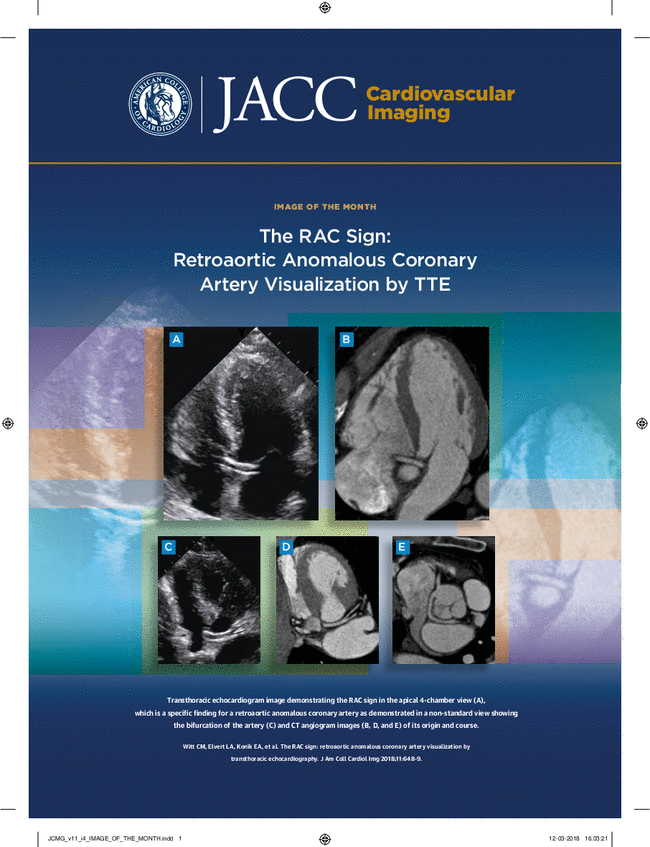Established and Emerging Fluorine-18–Labeled Cardiac PET Radiotracers
IF 12.8
1区 医学
Q1 CARDIAC & CARDIOVASCULAR SYSTEMS
引用次数: 0
Abstract
Positron emission tomography (PET)/computed tomography is a major imaging strategy for cardiovascular disease characterization. Whereas multiple radioisotopes can be used for PET imaging of cardiac disease processes, fluorine-18 (18F) presents key advantages. These include availability as a unit dose given a favorable half-life of 109.7 minutes and a short positron range leading to a high spatial resolution. In this context, there is growing interest in the development of novel 18F-labeled probes applied to cardiac PET imaging, which in turn provide clinicians with new methods to evaluate disease pathways of interest. Beyond 18F-fluorodeoxyglucose, used in routine clinical practice to scrutinize myocardial viability, cardiac sarcoidosis, as well as prosthetic valve and cardiac device infection, new 18F-labeled radiopharmaceuticals have undergone clinical evaluation. These include 18F-flurpiridaz, which was recently approved by the U.S. Food and Drug Administration for myocardial perfusion imaging and that is also amenable to accurate myocardial blood flow quantitation, 18F-sodium fluoride to detect metabolically active epicardial coronary atherosclerotic lesions, and the 18F-labeled amyloid radiotracers florbetapir, flutemetamol, and florbetaben. This review will further explore emerging 18F-labeled probes applied to cardiac sarcoidosis, myocardial innervation, and ongoing fibrosis/fibroblast activation.
已建立的和新兴的氟-18标记心脏PET放射性示踪剂。
正电子发射断层扫描(PET)/计算机断层扫描是心血管疾病表征的主要成像策略。尽管多种放射性同位素可用于心脏疾病过程的PET成像,但氟-18 (18F)具有关键优势。其中包括单位剂量的可用性,其有利的半衰期为109.7分钟,正电子范围短,导致高空间分辨率。在这种背景下,人们对开发用于心脏PET成像的新型18f标记探针越来越感兴趣,这反过来又为临床医生提供了评估感兴趣的疾病途径的新方法。除18f -氟脱氧葡萄糖用于常规临床检查心肌活力、心脏结节病以及人工瓣膜和心脏装置感染外,新的18f标记放射性药物也进行了临床评价。其中包括18f -氟吡达,最近被美国食品和药物管理局批准用于心肌灌注成像,也适用于准确的心肌血流定量,18f -氟化钠用于检测代谢活跃的心外膜冠状动脉粥样硬化病变,以及18f标记的淀粉样蛋白放射性示踪剂florbetapir、flutemetamol和florbetaben。本综述将进一步探讨新出现的18f标记探针在心脏结节病、心肌神经支配和正在进行的纤维化/成纤维细胞活化中的应用。
本文章由计算机程序翻译,如有差异,请以英文原文为准。
求助全文
约1分钟内获得全文
求助全文
来源期刊

JACC. Cardiovascular imaging
CARDIAC & CARDIOVASCULAR SYSTEMS-RADIOLOGY, NUCLEAR MEDICINE & MEDICAL IMAGING
CiteScore
24.90
自引率
5.70%
发文量
330
审稿时长
4-8 weeks
期刊介绍:
JACC: Cardiovascular Imaging, part of the prestigious Journal of the American College of Cardiology (JACC) family, offers readers a comprehensive perspective on all aspects of cardiovascular imaging. This specialist journal covers original clinical research on both non-invasive and invasive imaging techniques, including echocardiography, CT, CMR, nuclear, optical imaging, and cine-angiography.
JACC. Cardiovascular imaging highlights advances in basic science and molecular imaging that are expected to significantly impact clinical practice in the next decade. This influence encompasses improvements in diagnostic performance, enhanced understanding of the pathogenetic basis of diseases, and advancements in therapy.
In addition to cutting-edge research,the content of JACC: Cardiovascular Imaging emphasizes practical aspects for the practicing cardiologist, including advocacy and practice management.The journal also features state-of-the-art reviews, ensuring a well-rounded and insightful resource for professionals in the field of cardiovascular imaging.
 求助内容:
求助内容: 应助结果提醒方式:
应助结果提醒方式:


